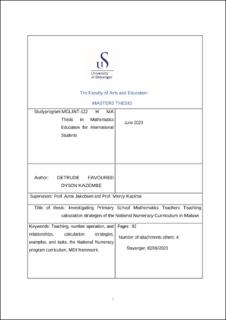| dc.description.abstract | In Malawi, the current performance of students in early-grade mathematics is low due to lack of focus on developing number concepts, as well as the reliance on rote learning in the existing OBE curriculum. To address these issues, a new curriculum has been introduced in 204 pilot schools, aiming to revise the mathematics curriculum for lower primary grades (Standards 1- 4). The revised curriculum focuses on teaching various calculation strategies within the core elements of numbers, operations, and relationships, with the goal of equipping students with a wider range of problem-solving skills and a deeper understanding of mathematical concepts. This study investigated how mathematics teachers teach calculation strategies in the new National Numeracy Curriculum. The research aimed to identify the calculation strategies taught, how teachers teach them, and their views on teaching of calculation strategies The following questions guided the study: 1) What calculation strategies do mathematics teachers teach in the NNP curriculum? 2) How do mathematics teachers teach calculation strategies in the NNP curriculum? 3) How do mathematics teachers view the teaching of calculation strategies in the NNP curriculum? The study used a mixed methods approach, employing the Mathematical Discourse of Instruction (MDI) analytical framework (Adler & Ronda, 2015) for data analysis. The findings indicated that mathematics teachers teach a diverse set of calculation strategies, including building up and breaking down, number lines, physical modeling, counting on and counting down, addition bubbles, estimation, number pyramid, doubling and halving, commutativity, completing 10s, rounding, and compensation. Teachers illustrated these strategies using examples and tasks, either selecting one question from workbooks as an example or formulating their own examples that involve multiple calculation strategies. The remaining tasks assigned to learners came from the workbooks. Teachers used various teaching aids such as workbooks, charts, tables, chalkboards, and physical models to demonstrate and explain the calculation strategies. They encouraged learner participation through whole-class discussions, group work, pair work, and individual work. Teachers emphasized the importance of naming, explaining, and justifying the chosen strategies and highlighted the contextual differences in applying calculation strategies to solve different types of questions. However, teachers perceived the allocated time for mathematics lessons as not enough and suggested either doubling the time or reducing the workload per page to facilitate more effective teaching and learning. | |
